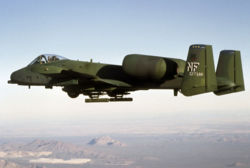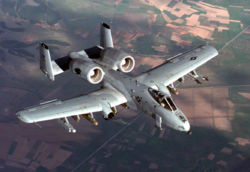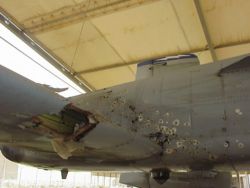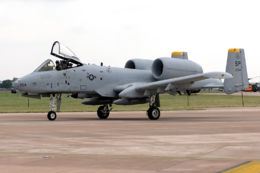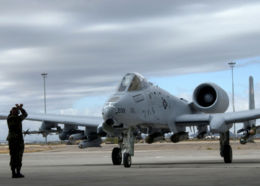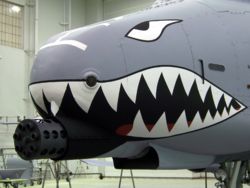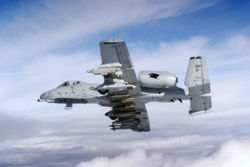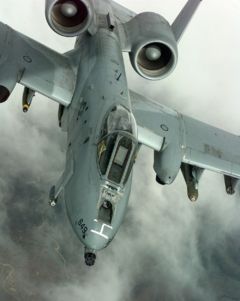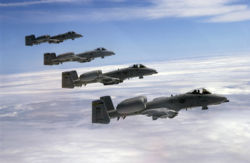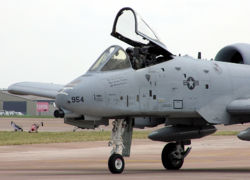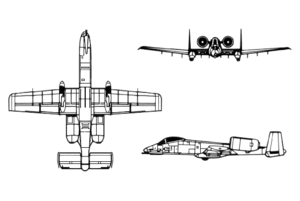PlaneSpottingWorld welcomes all new members! Please gives your ideas at the Terminal.
A-10 Thunderbolt II
| A-10 Thunderbolt II | |
|---|---|
| Type | close air support attack aircraft |
| Manufacturer | Fairchild-Republic |
| Maiden flight | 1972-05-10 |
| Introduced | March 1977 |
| Status | Active: 143 A-10s, 70 OA-10s Reserve: 46 A-10s, 84 OA-10s ANG: 84 A-10s, 18 OA-10s |
| Primary user | United States Air Force |
| Number built | 715 |
| Unit cost | US$9.8 million in 1998 |
The Fairchild-Republic A-10 Thunderbolt II is a single-seat, twin-engine jet aircraft designed to provide close air support (CAS) of ground forces by attacking tanks, armored vehicles, and other ground targets. As a secondary mission, it provides airborne forward air control, guiding other aircraft against ground targets. It is the first US Air Force aircraft designed exclusively for CAS. The official nickname comes from the P-47 Thunderbolt of World War II, a plane that was particularly effective at the CAS mission. However, the A-10 is more commonly known as Warthog or simply Hog. In the USAF inventory, the same airframe is also designated OA-10 when used primarily in a forward air control role.
Contents
History
The A-10 was developed in response to the increasing vulnerability of ground attack-planes to ground air defenses, as evidenced by the large number that were shot down by small arms fire, surface-to-air missiles, and low level anti-aircraft gunfire during the Vietnam War. This indicated the need for a specialized, heavily armored aircraft with long loiter time and large ordnance load, much like the Ilyushin Il-2 or A-1 Skyraider. Also, in WWII the Junkers 87 G-1 and G-2's tank-killing abilities with two underwing 37mm cannons, (reference pilot Hans-Ulrich Rudel), showed the requirement for a large caliber gun to be installed. In addition, the Hawker Hurricane Mk IID had knocked out tanks with underwing 40mm cannons and/or rockets.
On 6 March 1967 the US Air Force released a request for information to 21 companies. Their objective was to create a design study for a low cost attack aircraft designated A-X, or "Attack Experimental". In May 1970, the USAF issued a modified, and much more detailed request for proposals (RFP). Six companies submitted contestants to the USAF, with Northrop and Fairchild Republic selected to build prototypes: the YA-9A and YA-10A, respectively.
The YA-10A first flew in May 1972. After trials and a flyoff against the YA-9A, the Air Force selected Fairchild-Republic's YA-10A on 10 January 1973 for production. (There was an additional flyoff against the A-7D Corsair II, (the attack aircraft that was then being flown by the Air Force), to prove the need to purchase a new airplane). The first production A-10 flew in October 1975, and deliveries to the Air Force commenced in March 1976. The first squadron to use the A-10 went operational in October 1977. In total, 715 aircraft were produced, the last in 1984.
Two experimental A-10B two-seat version were built (contract was originally for 13). One was partially built and project was terminated due to the crash of one. The Night Adverse Weather aircraft was developed by Fairchild from an A-10 prototype for consideration by the USAF. It included a second seat for a weapons officer responsible for ECM, navigation, and target acquisition. The variant was cancelled and the only two-seat A-10 built now sits at Edwards Air Force Base awaiting a spot in the Flight Test Historical Foundation museum. The proposed two-seat A-10 trainer aircraft did not go into production, as it was felt that the A-10 was so simple to fly that a trainer aircraft was not required.
A-10s were initially an unwelcome addition to the arsenal in the eyes of Air Force brass. The Air Force prized the high-flying, high-performance F-15 Eagle and F-16 Fighting Falcon jets, and were determined to leave the dirty work of close air support to Army helicopters. Attempts to transfer the A-10 to the Army and the Marines were at first prevented by the 1948 Key West Agreement, and then by the A-10's impressive combat record during the Gulf War in 1991. Shortly after the war, the Air Force gave up on the idea of replacing the A-10 with a ground attack version of the F-16.[1]
The A-10 is scheduled to stay in service with the USAF until 2028, when it may be replaced by the F-35 Lightning II. Beginning in 2005 the entire A-10 fleet is being upgraded to the "C" model that will include improved FCS (fire control system), ECM (electronic countermeasures), and the ability to carry smart bombs. The A-10 will be part of a service life extension program (SLEP) with many receiving new wings.[2]
Features
The A-10 has superior maneuverability at low speeds and altitude, thanks to straight, wide wings with downturned "droop" wing tips. These also allow short takeoffs and landings, permitting operations from rugged, forward airfields near front lines. The plane can loiter for extended periods of time and operate under 1,000 feet (300 m) ceilings with 1.5-mile (2.4 km) visibility. It typically flies at a relatively slow speed of 180 knots (200 mph or 320 km/h), which makes it a much better candidate for the ground-attack role than fast fighter-bombers, which often have difficulty targeting small and slow-moving targets.
The 'Warthog' is exceptionally hardy, to the point that it could be considered an airborne tank. Its strong airframe can survive direct hits from armor-piercing and high-explosive projectiles up to 23 mm. The aircraft has triple redundancy in its flight systems, with mechanical systems to back up double-redundant hydraulic systems. This permits pilots to fly and land when hydraulic power or part of a wing is lost. The aircraft is designed to fly with one engine, one tail, one elevator and half a wing torn off. Self-sealing fuel tanks are protected by fire-retardant foam. Additionally, the main landing gear is designed so that the wheels semi-protrude from their nacelles when the gear is retracted so as to make gear-up landings (belly landing) easier to control and less damaging to the aircraft's underside.
The cockpit and parts of the flight-control system are protected by 900 lb (408.2 kg) of titanium armor, referred to as a "titanium bathtub." The tub has been tested to withstand multiple strikes from 20 mm cannon fire. The thickness of the titanium varies from ½ an inch to 1½ inches determined by a study of likely trajectories and deflection angles. This protection comes at a cost, though; the armor plating itself weighs almost 6% of the entire aircraft’s empty weight. To protect the pilot from the fragmentation likely to be created from impact of a shell any interior surface of the tub that is directly exposed to the pilot is covered by a multi-layer nylon spall shield. The protection for the pilot from above obviously comes second to the necessity for the pilot to have good all-round vision. The canopy cannot protect the pilot as well as the titanium, but the bullet-proof diffusion-bonded stretched-acrylic canopy can withstand small arms fire and is spall-resistant, although the canopy needs to be penetrable by the ejection seat.
Recent proof of the durability of the A-10 was shown when USAF Captain Kim Campbell, flying a ground support mission over Baghdad during the 2003 invasion of Iraq suffered extensive flak damage to her A-10. The hit damaged one of the A-10's two engines and destroyed its hydraulic system, disabling the plane's stabilizer and flight controls. Despite this, the pilot managed to fly it for an hour and landed it safely at the air base in manual reversion mode ("Killer Chick" tells her story).
Engine exhaust passes over the aircraft's horizontal stabilizer and between the twin tails, decreasing the A-10's infrared signature and lowering the likelihood that the aircraft can be targeted by heatseeking missiles. The placement of the engines partially shields them from anti-aircraft fire behind the wings and tail. The A-10 can fly even after the loss of one side of the tail, ⅔ of a single wing, and one engine.[citation needed]
The A-10 has integrally machined skin panels. Because the stringers are integral with the skin there are no join or seal problems. These panels, built using computer controlled machining, reduce the man-hours and hence the cost of manufacture. The tests of war have shown that this type of panel is more battle-hardy.
Most thin flat areas of the airframe are honeycomb panels. This is because thin honeycomb sandwich panels are less likely to deform in any direction than sheet metal panels even if part of the panel has been blown off or structurally compromised. Honeycomb panels of this type on the A-10 include the flap shrouds, the elevators, the rudders and other sections of the fins. The leading edge of the mainplane is honeycomb to provide strength with minimal weight compromise.
The ailerons are at the far ends of the wings to gain greater rolling moment as with most aircraft but there are two distinguishing features. First, the ailerons are larger than is typical, almost 50% of the chord, providing improved control even at slow speeds. The aileron is also split, allowing the halves to separate and function as airbrakes.
The Thunderbolt II can be serviced and operated from bases with limited facilities near battle areas. An unusual feature is that many of the aircraft's parts are interchangeable between the left and right sides, including the engines, main landing gear, and vertical stabilizers. The sturdy landing gear, low-pressure tires and large, straight wings allow operation from short rough strips even with a heavy ordnance load, allowing the aircraft to operate from damaged airbases. The aircraft is designed to be refueled, rearmed, and serviced with minimal equipment. Operating from a forward area is both useful for close air support and necessary due to the A-10's relatively low cruise and top speeds.
One of the characteristic features of this aircraft is the placement of the General Electric TF34-GE-100 turbofan engines. There are many reasons for the location of the engines on the Warthog. First, as this aircraft was expected to be operated from forward air bases, often with semi-prepared substandard runways, there would be a high risk of FOD (Foreign Object Damage). The height of the engines significantly lowers the chance of sand or stones damaging the complex parts of the jet engines. This also means engines can remain running, allowing for shorter servicing and rearming turn-around times by ground crew. Servicing and rearming are further helped by having wings closer to ground than would be possible if the engines were wing mounted. As mentioned above the position also reduces the IR signature which starts low anyway due to the high bypass ratio of the engines. The bypass ratio is 6:1 and so the engines are very quiet which reduces the risk of detection. Because of their high position, the engines are angled upward nine degrees to bring the combined thrust line closer to the aerodynamic center of the aircraft. This avoids trimming measures to counteract a nose-down pitching moment if the engines were parallel to the fuselage. The engines, being particularly heavy components, require strong supports. Accordingly, forged engine-mounting nacelle frames are pin jointed to machined support beams.
All four fuel tanks are near the center of the aircraft thus decreasing the likelihood of them being hit or being separated from the engines. There are several methods employed to protect the tanks themselves. The tanks are separate from the fuselage and so projectiles would need to penetrate the skin before reaching the tank. The refueling system is purged after use so that there is no fuel unprotected anywhere in the aircraft. All pipes self-seal if they are compromised. Most of the fuel system components are situated inside the tanks so that if a leak were to occur from the component the fuel would not be lost. If a tank does get damaged there are check valves that can ensure that fuel does not flow into the compromised tank. The most important fuel system protection aid is the reticulated polyurethane foam that is sprayed into the empty space in a tank holding debris and restricting fuel spillage in the event of damage. The other source of possible combustion, the engines, are shielded from the fuel system and the rest of the airframe by firewalls and fire extinguishing equipment.
Because of the close promity of the front landing gear and the A-10's main cannon, the landing gear is offset to starboard and cannon slightly to port (see schematic below). The offset front landing gear causes the A-10 to have dissimilar turning radii. Turning to the right on the ground takes less space than turning left.[citation needed]
Weapons Systems
Although the A-10 can carry a considerable weight of disposable stores, its primary built-in weapon is the 30 mm GAU-8/A Avenger Gatling gun. One of the most powerful aircraft cannons ever flown, it fires large depleted uranium armor-piercing shells at a rate of about 3,900 rounds per minute (50 rounds per second during the first second, 70 rounds per second thereafter). The massive shells and high muzzle velocity allow the Thunderbolt II to destroy heavily armored main battle tanks with as few as six direct hits. The gun is accurate as well, being capable of placing 80% of its shots within a 20-foot wide circle from a distance of 1 mile while the aircraft is in flight.
The fuselage of the plane is actually built around the gun. For example, the nosewheel is offset to starboard so that the gun's firing barrel is aligned on the aircraft's centerline. The A-10 carries 1,350 rounds of 30 mm ammunition. The damage caused by a portion of those rounds firing prematurely due to impact of an explosive shell would be catastrophic. It is for this reason that a great deal of effort has been taken to protect the 5 ft (1.52 m) wide, 9 ft (2.74 m) long drum. There are many plates of differing thicknesses between the skin and the drum. These plates are called trigger plates because when an explosive shell hits a target it first penetrates its armor, then detonates. As the drum has many layers of thin armor the shell's detonation is triggered before reaching the drum. A final layer of armor around the drum itself protects it from fragmentation damage.
Another commonly used weapon is the AGM-65 Maverick air-to-surface missile, with electro-optical targeting. The Maverick allows targets to be engaged at much greater ranges than the cannon, a safer proposition in the face of modern anti-aircraft systems. During Desert Storm, in the absence of night vision goggles, the Maverick's camera was used for night missions. Other weapons include cluster bombs and rocket pods. It is also capable of carrying Hellfire missiles. Although the A-10 is equipped to deliver laser-guided bombs, their use is relatively uncommon; at the low altitudes and speeds of typical A-10 operations, standard unguided bombs provide adequate accuracy at far lower cost. In any event, the guided weapons would provide little benefit, as there would be nearly no time for the weapons to steer onto a target. A-10s usually fly with an ECM pod under one wing and two AIM-9 Sidewinder air-to-air missiles under the other for self-defense.
Criticisms
The A-10 has been criticized for its minimal avionics fit. It was originally intended purely for close air support, for which it was felt that complex electronics would be unnecessary (and would have had an undesirable effect on serviceability and cost). Initial fit provided basic communications, a radar-warning system, and TACAN navigation, early aircraft lacking even an autopilot. As USAF emphasis shifted towards the anti-armor role, presumably in a conflict with the Warsaw Pact forces in Western Europe, where weather is frequently poor, there was pressure for improved sensors and electronics. Fairchild-Republic offered a two-seat Night and Adverse Weather (NAW) variant beginning in 1977, but it was not adopted. Aircraft were eventually upgraded with inertial navigation and a Pave Penny laser sensor (marked target seeker) pod that allowed the pilot to detect laser energy for PID (Positive Identification) of an illuminated target. The Pave Penny is a passive seeker and cannot self-designate a target for a Laser Guided Bomb (LGB). However, the A-10 can drop LGBs with the help of another aircraft (Buddy-Lase) or, when equipped with a targeting pod (Self-Lase).
The A-10 also initially lacked systems to compute target range or impact points, greatly limiting its ability to deliver weapons other than cannon and rocket fire (in direct, visual-range attacks) or the self-guided AGM-65 Maverick missile, whose own sensors displayed imagery in the A-10's cockpit. Often this small monitor would provide the only source of imagery for missions that took place in dark environments. Much later in the A-10's career, the Low-Altitude Safety and Targeting Enhancement (LASTE) upgrade provided computerized weapon-aiming equipment, an autopilot, and ground-collision warning system. The A-10 is now compatible with night-vision goggles for low-light operation. In 1999, aircraft began to be given Global Positioning System navigation systems.
With the end of the Cold War and the decreasing likelihood of combat with heavy mechanized forces, the continued need for the tank-busting A-10 has been questioned. Several efforts to withdraw the A-10 Thunderbolt from active service have been made over the years. However in recent conflicts, such as the 2001 war in Afghanistan and the 2003 invasion of Iraq the A-10 has shown that it can still destroy modern armoured vehicles.
Operational service
The first unit to receive the A-10 Thunderbolt II was the 355th Tactical Training Wing, based at Davis-Monthan Air Force Base, Arizona in March 1976.
The A-10 saw combat for the first time during the Gulf War in 1991, destroying more than 1,000 Iraqi tanks, 2,000 military vehicles, and 1,200 artillery pieces. A-10s shot down two Iraqi helicopters with the GAU-8 gun.[3] Five A-10s were shot down during the war (a number of those by ZSU-23-4 Shilka anti-aircraft systems[citation needed]), far fewer than military planners expected. A-10s had a mission capable rate of 95.7%, flew 8,100 sorties, and launched 90% of the AGM-65 Maverick missiles fired in the conflict.[1]
In the 1990s many A-10s were shifted to the forward air control (FAC)" role and redesignated OA-10. In the FAC role the A-10 is typically equipped with up to six pods of 5 inch (127 mm) Zuni rockets, usually with smoke or white phosphorus warheads used for target marking. They remain fully combat capable despite the redesignation.
A-10s again saw service in the 1999 Kosovo War, in the later stages of the 2001 invasion of Afghanistan, in Operation Anaconda in Afghanistan in March 2002, and in the 2003 Iraq war. In Afghanistan the A-10 is based at Bagram.
On April 30th, 2003, USCENTAF issued Operation Iraqi Freedom: By the Numbers, a declassified report about the aerial campaign in the conflict. Sixty A-10s were deployed in Iraq; one was shot down near Baghdad International Airport by Iraqi fire late in the campaign. Of the A-10s deployed, 47 were Air National Guard Aircraft, and 12 were from the Air Force Reserve. The A-10 had a mission capable rate of 85% in the war, and fired 311,597 rounds of 30 mm ammunition. The A-10 also flew 32 missions in which the aircraft dropped propaganda leaflets over Iraq.[4]
The A-10 is scheduled to stay in service with the USAF until 2028, when it may be replaced by the F-35 Lightning II. The entire A-10 fleet is currently undergoing upgrades. The A-10 could stay in service much due to its low cost and its unique capabilities which the F-35 simply cannot incorporate — such as its cannon, ruggedness, and slow flying capabilities.
Nicknames
How the A-10 Thunderbolt II received the nickname "Warthog" (or simply "Hog"), dates back to Fairchild-Republic's initial deliveries. There are several rumors that the name was derived from the report of the main gun, which has a surprisingly low pitch and sounds much like the snorting or grunting of a hog. This, coupled with the A-10's lack of aesthetic appeal and thick skin, make the aircraft reminiscent of a warthog.
Another suggested reason was that for production economy, the fuselage used different types of rivets. Only those forward of the trailing edge of the wing are flush-head. Those aft of the wing are protruding-head, which makes the skin surface look and feel "bumpy". (This was done since the boundary layer separates at this point on the fuselage, and therefore the bumpiness does not affect the drag of the aircraft.) When the A-10 was first delivered to Davis-Monthan AFB, the crew chiefs thought the protruding head rivets looked like warts, and dubbed the A-10 "the Warthog".
The "Hog" nickname also dates back to its predecessors. The F-84 Thunderjet was front-heavy and would sometimes tip over, leaving its nose in the mud, leading to the "Hog" designation. Future planes in the lineage carried on the nickname tradition, with the F-84F Thunderstreak being the "Super Hog," and the F-105 Thunderchief being the "Ultra Hog."
Variants
- YA-10A : The first two prototypes.
- A-10A : Single-seat close air support, ground-attack version.
- OA-10A : Single-seat forward air control version.
- Night/Adverse Weather A-10 : Two-seat experimental prototype, for night and adverse weather work. Later redesignated YA-10B. Only one example was built, which is now on static display.
- A-10C : Updated version of A-10 featuring a glass cockpit, and all-weather multi-mission precision weapons and laser targeting capability.
Operators
The A-10 has been flown exclusively by the United States Air Force and its Air Reserve Components, the Air Force Reserve and the Air National Guard. As of September 30, 2005, 17 squadrons operate the A-10 or its OA-10 variant (8 USAF, 6 ANG, and 3 AFR).
USAF A-10/OA-10 units
- 23d Fighter Group - Pope Air Force Base, North Carolina
- 51st Fighter Wing - Osan AB, South Korea
- 52d Fighter Wing - Spangdahlem Air Base, Germany
- 354th Fighter Wing - Eielson Air Force Base, Alaska *Planned BRAAC unit closure
- 355th Wing - Davis-Monthan Air Force Base, Arizona
Air National Guard units
- 103d Fighter Wing - Bradley ANGB, Connecticut
- 118th Fighter Squadron
- 104th Fighter Wing - Barnes ANGB, Massachusetts
- 131st Fighter Squadron
- 110th Fighter Wing - Battle Creek ANGB, Michigan
- 172nd Fighter Squadron
- 111th Fighter Wing - Willow Grove ARS, Pennsylvania
- 103rd Fighter Squadron
- 124th Wing - Boise Air Terminal, Idaho
- 190th Fighter Squadron
- 175th Wing - Martin State Airport, Maryland
- 104th Fighter Squadron
Air Force Reserve Units
- 442d Fighter Wing - Whiteman Air Force Base, Missouri
- 303rd Fighter Squadron
- 917th Fighter Wing - Barksdale Air Force Base, Louisiana
- 47th Fighter Squadron
- 926th Fighter Wing - NAS JRB New Orleans, Louisiana
- 706th Fighter Squadron
Specifications (A-10 Thunderbolt II)
Data from The Great Book of Modern Warplanes[2]
General characteristics
- Crew: 1
- Length: 53 ft 4 in (16.26 m)
- Wingspan: 57 ft 6 in (17.53 m)
- Height: 14 ft 8 in (4.47 m)
- Wing area: 506 ft² (47.0 m²)
- Airfoil: NACA 6716 root, NACA 6713 tip
- Empty weight: 24,959 lb (11,321 kg)
- Loaded weight:
- Standard: 30,384 lb (13,782 kg)
- On CAS mission: 47,094 lb (21,361 kg)
- On anti-armor mission: 42,071 lb (19,083 kg))
- Max takeoff weight: 50,000 lb (23,000 kg)
- Powerplant: 2× General Electric TF34-GE-100A turbofans, 9,065 lbf (40.32 kN) each
Performance
- Never exceed speed: 450 knots (520 mph, 830 km/h)
- Maximum speed: 380 knots (438 mph, 704 km/h) at 5,000 ft (1,500 m) with 6 Mk 82 bombs
- Cruise speed: 300 knots (340 mph, 560 km/h)
- Combat radius:
- On CAS mission: 250 nm (290 mi, 460 km) at 1.88 hour single-engine loiter at 5,000 ft (1,500 m), 10 min combat
- On anti-armor mission: 252 nm (166 mi, 267 km), 40 nm (45 mi, 75 km) sea-level penetration and exit, 30 min combat
- Ferry range: 2,240 nm (2,580 mi, 4,150 km) with 50 knot (55 mph, 90 km/h) headwinds, 20 minutes reserve
- Service ceiling: 45,000 ft (13,700 m)
- Rate of climb: 6,000 ft/min (30 m/s)
- Wing loading: 99 lb/ft² (482 kg/m²)
- Thrust/weight: 0.36
Armament
- Guns: 1× 30 mm (1.18 in) GAU-8/A Avenger gatling gun with 1,350 rounds
- Hardpoints: 8× under-wing and 3× under-fuselage pylon stations holding up to 16,000 lb (7,200 kg) and accommodating:
- Mark 82, Mark 83, and Mark 84 general-purpose bombs or
- Mk 77 incendiary bombs or
- BLU-1, BLU-27/B Rockeye II, BL755 and CBU-52/58/71/87/89/97 cluster bombs or
- GBU-10 Paveway II, GBU-12 Paveway II, GBU-16 Paveway II and GBU-24 Paveway III laser-guided bombs or
- AGM-65 Maverick air-to-surface missiles and AIM-9 Sidewinder air-to-air missiles or
- LAU-68 Hydra 70 mm (2.76 in) and 127 mm (5.0 in) rocket pods or
- Illumination flares, ECM and chaff pods or
- ALQ-131 ECM pod
References
- ↑ A-10/OA-10 USAF fact sheet
- ↑ Spick, M. (2000). The Great Book of Modern Warplanes. Salamander Books, 21. ISBN 1-84065-156-3.
External links
- USAF A-10 fact sheet page
- A-10.org website
- A-10 web page on globalsecurity.org
- A-10 web page on fas.org
- The Warthog Pen website
- A-10 cockpit video.
Related content
Comparable aircraft
Designation sequence
Related lists
Lists relating to aviation | |
|---|---|
| General | Timeline of aviation · Aircraft · Aircraft manufacturers · Aircraft engines · Aircraft engine manufacturers · Airports · Airlines |
| Military | Air forces · Aircraft weapons · Missiles · Unmanned aerial vehicles (UAVs) · Experimental aircraft |
| Notable incidents and accidents | Military aviation · Airliners · General aviation · Famous aviation-related deaths |
| Records | Flight airspeed record · Flight distance record · Flight altitude record · Flight endurance record · Most produced aircraft |
